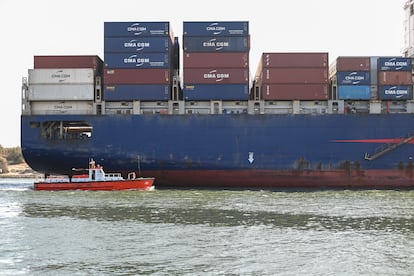Military escalation in Yemen raises the specter of a new economic short-circuit
The combined US-UK attack puts the Red Sea trade route in jeopardy and threatens to increase prices, although experts view the risks as contained for now


The attack by the United States and the United Kingdom on Houthi positions in Yemen threatens to ignite the powder keg that is the Middle East and open a new fault line in the global economy. The transit of merchant ships through the Red Sea, the main trade artery linking Asia to Europe via the Suez Canal, plummeted in December after assaults by Yemeni rebels intensified. Now, the military escalation is pushing the short-term possibility of a return to normality farther into the distance. It also raises the spectre of an economic short-circuit, whose features are similar to the gap between supply and demand that was experienced after the lockdowns due to the pandemic: bottlenecks in logistics chains, delays in the delivery of goods, suspensions in industrial production, and upward pressures on prices.
The ingredients are similar, except that it is not yet clear whether a regional incident could trigger a global crisis. On Friday Tesla announced a two-week shutdown at its electric car factory in Germany. Other retailgiants such as Tesco and Ikea have already warned of possible delays in product deliveries, the price of oil is rebounding, and there are voices predicting rises in prices that have not yet been fully tamed in the context of a general slowdown.
About 12% of global trade passes through the Red Sea — 15%, according to the US — which accounts for 30% of all the world’s container traffic. Maersk, one of the world’s largest shipping companies, is responsible for 20% of global trade. Its chief executive, Vincent Clerc, is one of those who sees the glass half empty. He does not see clear solutions in the short term and speaks bluntly about the uncertainty that the future holds: “It is unclear to us if we are talking about re-establishing safe passage into the Red Sea in a matter of days, weeks, or months … It could potentially have quite significant consequences on global growth,” he told the Financial Times.
Global trade fell 1.3% in December from the previous month, and much of this decline is linked to turmoil in the Red Sea, according to a study published on Thursday by German think tank IfW Kiel. After declaring their support for Hamas, Houthi rebels have increased their attacks on cargo ships transiting the area, and the decision of many shipping companies to undertake alternative itineraries that are longer but safer, has meant that the number of containers that travel this route every day fell by 66% in the last two months of 2023, from 500,000 to 200,000 units. Denmark’s Maersk is one of the companies that has temporarily left the area, as have other industry giants such as Hapag-Lloyd.
The EU is the most affected
The Red Sea route is an essential factor in the EU’s international trade, and the bloc has been severely hit by the attacks on shipping. Its exports fell by 2% in December compared to the previous month and imports were reduced by 3.1%, according to the trade indicator drawn up by IfW Kiel. In the case of the United States, which is less dependent on the route, the decline has been 1.5% and 1%, respectively, and 1.3% and 3% in the case of China.
“Shipping companies said about three weeks ago that they would start diverting their ships via the Cape of Good Hope [in South Africa, to avoid transit through the Red Sea], but only 80% in terms of volume did so,” Jordi Espín, secretary general of the Transprime manufacturers’ association, said by telephone. The change of route means extending journeys between Asia and Europe by an average of about 12 days, so the transport time has grown from between 38 and 42 days on average to about 55. The main problem, the expert points out, is not, however, the delays, but that many shipping companies are not taking the product to the closest point to the importer: “You don’t know where they are going to leave the goods or how much the transport is going to cost until the last minute. This uncertainty is fatal for the industry.”
Freight prices for the affected route from Asia to Europe have skyrocketed, from about $1,500 per container to about $4,500 or €4,100. Added to this cost are the surcharges imposed by shipowners for changing routes — about $2,000 on average per containe — says Espín He also acknowledges that there is a risk of an inflationary uptick, which, however, will be seen “in slow motion.” “If we compare the current situation with the pandemic, it is completely different. Then there was a halt in global demand, a crisis, and a global disruption. Now it is a regional incident, although it seems that the shipping companies intend to escalate the crisis on a global scale.”
In fact, the share prices of many of the big companies in the sector — Maersk, MSC, Hapag-Lloyd — rebounded in December after the attacks by Houthi militias. On Friday, however, its shares were falling. The price of Brent crude, the benchmark in Europe, has risen after the retaliation by Washington and London, and this Friday it was nearing $80 a barrel. According to the consulting firm Vortexa, up to nine trillion barrels of oil transited through the Suez Canal every day in the first half of 2023. According to the International Monetary Fund (IMF), a 10% increase in oil prices would correspond to hit of two-tenths of GDP globally and a rise in prices of between 0.2% and 0.4%.
The Suez Canal was blocked three years ago, when the Ever Given, one of the world’s largest container ships, ran aground on its banks. It then took six days to get the ship afloat. It was March 2021, the coronavirus crisis was still raging, and inflation began to rise, driven by the end of lockdowns. “The current situation is not comparable to that experienced during the Ever Given accident in the Suez Canal and the coronavirus pandemic, when lockdowns led to a drastic reduction in the supply of goods and at the same time demand in Europe skyrocketed,” the IfW Kiel study concludes. “Apart from a slightly longer lead time for products from the Middle East and rising transport costs, to which the container shipping network should adapt quickly, negative consequences for global trade should not be expected,” he adds.
Sign up for our weekly newsletter to get more English-language news coverage from EL PAÍS USA Edition
Tu suscripción se está usando en otro dispositivo
¿Quieres añadir otro usuario a tu suscripción?
Si continúas leyendo en este dispositivo, no se podrá leer en el otro.
FlechaTu suscripción se está usando en otro dispositivo y solo puedes acceder a EL PAÍS desde un dispositivo a la vez.
Si quieres compartir tu cuenta, cambia tu suscripción a la modalidad Premium, así podrás añadir otro usuario. Cada uno accederá con su propia cuenta de email, lo que os permitirá personalizar vuestra experiencia en EL PAÍS.
¿Tienes una suscripción de empresa? Accede aquí para contratar más cuentas.
En el caso de no saber quién está usando tu cuenta, te recomendamos cambiar tu contraseña aquí.
Si decides continuar compartiendo tu cuenta, este mensaje se mostrará en tu dispositivo y en el de la otra persona que está usando tu cuenta de forma indefinida, afectando a tu experiencia de lectura. Puedes consultar aquí los términos y condiciones de la suscripción digital.
More information
Archived In
Últimas noticias
Maduro counterattacks Trump with rhetoric and announces downing of nine drug trafficking aircraft
‘Ecce Homo’: The miraculous disaster that made a small Spanish town famous
Return to sex testing at the Olympics: IOC edges closer to banning transgender women
Trump escalates conflict with Venezuela with the start of covert operations
Most viewed
- Sinaloa Cartel war is taking its toll on Los Chapitos
- Oona Chaplin: ‘I told James Cameron that I was living in a treehouse and starting a permaculture project with a friend’
- Reinhard Genzel, Nobel laureate in physics: ‘One-minute videos will never give you the truth’
- Why the price of coffee has skyrocketed: from Brazilian plantations to specialty coffee houses
- Silver prices are going crazy: This is what’s fueling the rally










































